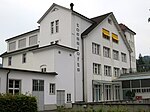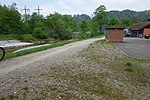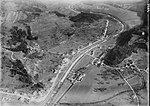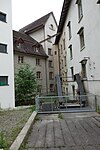Run-of-river power plants on the Töss
The run-of-river power plants on the Töss used the water of the Töss from Bauma in the Zurich Oberland downstream to the confluence with the Rhine at Tössegg almost continuously. The mechanized cotton spinning mills on the Töss were among the first on the continent.
industrialization
From 1800 the mechanization of the cotton industry led to a strong industrialization of the whole Töss valley with factory complexes, some of which were connected by canal systems.
In 1802 the Hard spinning mill was opened in Winterthur-Wülflingen as the first . In the upper Tösstal , mechanization began in 1817 with the lower Rikon mill , the first spinning mill. Heinrich Guyer's first spinning mill followed in 1821 at the Bauma mill, in 1824 the spinning mill at the upper Rikon mill, 1824/1825 the Eskimo spinning mill in Turbenthal , the upper Turbenthal spinning mill and the Rämismühle spinning mill in 1825 and the Neuthal spinning mill in 1827 .
The early spinning mills took over the water rights and water pipes from older, married mills that had no water rights interest to pay. Originally there were 34 hydropower plants between Bauma and Sennhof : Bauma 12, Wila 5, Turbenthal 6, Rämismühle 1, Zell 2, Rikon 4, Kollbrunn 3 and Sennhof 2. They were operated with Francis turbines , some Kaplan turbines and a few water wheels .
Between 1980 and 2010, the spinning and weaving mills in Steg, Bauma, Wila, Turbenthal, Rämismühle and Kollbrunn, Pfungen , Freienstein ZH and Rorbas were shut down. The Sennhof spinning mill was the last to cease operations in 2016. Some of their hydropower plants have been refurbished and are still in operation.
Upper Tösstal
The Töss rises on the Tössstock and flows from Steg in the Tösstal to Bauma, past Juckern, Blitterswil, Saland and Tablat to Wila, Turbenthal, Zell, Rikon and Kollbrunn, before reaching the Linsental (Leisental) and the Winterthur Töss district after Sennhof . From Steg the Töss and its side streams were used for industrial purposes. From Wila to Leisental there is a once shared canal system, the Tössgewerbe Canal.
Legend: ID = water law, cat. = Gross gradient, type = output in megawatts
| ID | photo | object | Cat. | Type | address | Coordinates |
|---|---|---|---|---|---|---|
| 3 |

|
Grünthal weaving mill 1856–1988, Juckeren, Wasserschloss | Saland, Juckeren, Bauma | 707381 / 249273 |
Tössgewerbekanal
The Tössgewerbe Canal is a twelve kilometer long canal system in the upper Tösstal between Wila (Blautopf groundwater pond 558 m above sea level , Rosenberg silk weaving mill) and Sennhof (Leisental Kyburgerbrücke 463 m above sea level ). Originally the power stations of 14 factories with a gross output of 2090 hp were connected.
The first spring was taken on the right bank of the Töss in the Ifang in Turbenthal. Ulrich Bühler AG was allowed to use Tösswasser for the first time in 1846 for its saws and machine knife factory in Turbenthal (water law No. 58). The often dried up Töss was the reason that in 1868 and 1877 water from the valley flanks to the left of the Töss water was discharged into the canal. In Wila, the groundwater surge in the Espi, the Hüttlibach and the Mülibach was carried out in a wooden culvert under the Töss. The owners at the Tössgewerbekanal received in 1884 the approval of the Töss to take 500 liters of water per second, in 1920 it was 1000 liters and in 1948 1500 liters.
After the flood disaster of 1876, the canal system had to be largely renewed. In 1886 the water of the Turbenthaler Katzenbach was fed to the commercial canal. In 1920 the company of waterworks owners Turbenthal-Rämismühle was founded (water law No. 65). The hydropower plants of all factories along the Töss used the water from the commercial canal one after the other in uninterrupted succession: the underwater canal of one factory became the upstream canal of the next factory after a few 100 meters. In Rämismühle, after the Stahel cotton spinning mill, the water was conducted in a siphon line under the Töss to the left bank, where it drove the Hornsagi and spit the Himmerichweiher.
In 1978, the canton, municipalities and waterworks owners looked for a joint solution for the complex and expensive canal maintenance. The most intensively used section from the Töss water intake (Turbenthal swimming pool) to Eskimo Textil (Hutzikon) of the Tössgewerbe Canal should be preserved and the rest of the water covered. The Turbenthal community has restored its facility behind the community center (Wasserrecht No. 60, Boller-Winkler / Schlossberg) as an operational museum.
Today (2018) the canal is used by four power plants (operators of the Bühler and Axpo spinning mills) with 1273 HP: The water is diverted through two sockets at the weir system in Schöntal (Kollbrunn) and flows to the turbine systems of the upper and lower Kollbrunn spinning mills (water rights No. 100 and 49). The upper water canal has been running over the Töss with a pipeline aqueduct (first pressure line from the Sulzer brothers ) since 1877 . From Kollbrunn, the water is forwarded to the Sennhof spinning mill and the Linsental power plant (water rights No. 35 and 78). Originally, the hydropower was transferred from the Linsental, 700 m downstream, to the Sennhof spinning mill by means of rope transmission. In connection with the remediation of residual water and buildings to increase production (Kollbrunn), the unlimited concessions of the Schöntal-Kollbrunn-Sennhof power plant chain are to be limited to 2043.
Hydropower plants on the Tössgewerbe Canal
Legend: ID = water law (No. 65 joint water law of the Society of Water Rights OwnersTurbenthal-Rämismühle ), cat. = Gross gradient, type = output in megawatts.| ID | photo | object | Cat. | Type | address | Coordinates |
|---|---|---|---|---|---|---|
| 58, 65 |

|
Ulrich Bühler AG, Zollinger spinning mill, 1825 | 3.96 | 0.023 | Gmeinwerch, Tösstalstrasse 140, Turbenthal |
706149 / 254196
|
| 58, 65 |

|
Boller Winkler AG 1867–1918, mill 17th century | 4.23 | 0.025 | Müliweg 1, Turbenthal |
706210 / 254836
|
| 203 |

|
Tössgewerbekanal | Chatzenbach, Turbenthal |
706038 / 254856
|
||
| 60, 65 |

|
Boller Winkler spinning mill 1872–1986, turbine house | 1.91 | 0.015 | Waidliwies, Bahnhofstrasse 7 bei, Turbenthal |
706051 / 255061
|
| 61, 65 |

|
Eskimo Textil, Johannes Wolf spinning mill, 1825 | 2.71 | 0.023 | Hutzikon, Tösstalstrasse 48, Turbenthal |
705953 / 255262
|
| 62, 65 |

|
Boller Winkler AG Fridtal 1833–2007, hydropower plant | 5.28 | 0.066 | Fridtal, Tösstalstrasse 14 bei, Turbenthal |
705929 / 255284
|
| 88, 65 |

|
Upper Rämismühle Boller Winkler spinning mill 1860–1983 | 6.29 | 0.070 | Rämismühle |
704528 / 255204
|
| 89, 65 |

|
Spinning mill Stahel Rämismühle 1825–1983, Mühle 1271, power center | 5.35 | 0.075 | Alte Tösstalstrasse 46–56, Rämismühle |
704276 / 255149
|
| 92 |

|
Hydrometric measuring station | Töss-Rämismühle |
703777 / 255601
|
||
| 92 |

|
City of Winterthur, Stahel Hornsagi 1879–1977, drop lifter end shaft | 4.58 | 0.034 | Horn saw, Rämismühle |
703541 / 255716
|
| 104 |

|
Upper spinning mill Rikon JJ Höhn 1824–1947 and Himmerichweiher | Neschwilerstrasse 19, Rikon |
702482 / 255532
|
||
| 142 |

|
Kuhn metal goods factory, Bleuler spinning mill 1817, Mühle 1274 | 9.64 | 0.181 | Mühleweg 11, Rikon |
702219 / 255731
|
| 144 |

|
Schöntal spinning mill 1851–1975, weir system | 5.84 | 0.098 | Schöntal, Rikon |
702139 / 256406
|
| 100 |

|
Upper Hermann Bühler spinning mill 1851–1975, turbine house | 8.86 | 0.206 | Au, Kollbrunn |
700995 / 256884
|
| 49 |

|
Middle / lower spinning mill Eduard Bühler 1837–1994 | 9.46 | 0.37 | Töbeli, Tösstalstrasse 22–24, Kollbrunn |
700359 / 257323
|
| 35 |

|
Lower spinning mill Hermann Bühler AG Sennhof 1859–2016 | 10.86 | 0.47 | Hermann Bühler area, Sennhof, Illnau-Effretikon |
699316 / 258093
|
| 78 |

|
Sennhof spinning mill, Linsental power station 1864 | 7.46 | 0.20 | Hermann Bühler area, Kyburg, Illnau-Effretikon | 698766 / 257644 |
Töss 91 water educational trail
To celebrate the 700th anniversary of the Swiss Confederation , the municipalities of Bauma, Turbenthal, Wila, Wildberg, Winterthur, Zell and the Canton of Zurich had the 15 km long «Töss 91» water trail built in 1991. At important locations along the water nature trail, educational boards have been set up which, together with a brochure and a leaflet, describe individual aspects of the Töss in terms of hydrology, geology and water management.
Lower Töss Valley
In the lower Töss valley, the Töss flows through the Winterthur districts of Töss and Wülflingen and the communities of Neftenbach , Pfungen, Dättlikon , Embrach , Rorbas and Freienstein-Teufen , where it flows into the Rhine at Tössegg.
In the 13th century, the Dominican convent in Töss ran a mill on a short river drainage. A commercial sewer with four inclines for seven turbines was built in stages. The Rieter Obertöss turbines were shut down in the 1990s. Later, operations for the sale of green electricity were resumed and the two Kaplan turbines from 1934 were overhauled. The improved control technology has an output of 100 and 170 kilowatts. In the Rieter power plant in Niedertöss, the Rieter triple turbine from 1914, including the old controller, was refurbished for continued operation.
The Wespi mill at the middle Töss waterfall in Wülflingen is the last intact industrial ensemble with weir, canal, turbine, transmission drive and complete milling machinery in the canton of Zurich. The Wespimühle had up to nine water wheels. The boiler turbine built by the Rieter machine works in Winterthur has been driving the Wespimühle since 1893. The eco-power plant supplies around 40 households with green electricity.
The residential and factory buildings and the sewer structures of the Beugger spinning mill , Schlosstal Clinic since 1894, were built between 1818 and 1819. Initially, a 40 hp water wheel provided the motor power. In 1875 a new turbine house was built on the right bank of the Töss, from which a 407 meter long wire rope transmission led to the spinning mill. The underwater canal of the Wespimühle was extended as an upper water canal by 332 meters to the turbine house. The 543 meter long drainage channel led through a culvert under the Eulach and around 60 meters above the Hard weir into the Töss.
The Hard spinning mill is the first factory and machine spinning mill on the continent. It was built 1801–1802 on the western edge of Wülflingen an der Töss. The Hard small hydropower plant has been “naturemade star” certified since 2002. The power plant, which was renovated in 2015, supplies 725 households with green electricity.
The small power station Pfungen of toesStrom AG lies at the end of a valley cut that the river Töss has dug between Pfungen and Freienstein. In 1853, a three-meter high solid weir was built in this natural fall, which fed the canal to the power station of the Pfungen ceiling and cloth factory and the Cholschwärzi pond. The Pfungen small power plant was built by the Canton of Zurich together with the construction of the weir . It started operations in 1994 and is now owned by the EKZ .
In 1854, the Ernst wool factory , which included a carding mill, a spinning mill, a weaving mill and a fulling mill, was opened. In 1900, the Swiss blanket and cloth factory in Pfungen-Turbenthal was created through the merger of the Ernst wool factory with a blanket factory in Turbenthal (later Eskimo AG). After the operation of the two-stage power plant had ceased in 1854, the Canton of Zurich bought back the water rights in 1977.
A high-speed turbine from Escher Wyss AG with 264 hp was installed at the Blumer Biedermann cotton spinning mill in Freienstein . In 1856 the company was expanded to include a colored weaving mill. A foundry was built for the production of around 400 looms. In 1889, the Jakobstal spinning mill in Bülach and the Oberhöri spinning mill were purchased. In its heyday, Blumer employed almost 1,000 people. In January 1945 the company was named Blumer Söhne + Cie AG. The spinning mill was closed in 1990 and the power plant shut down. The power plant from 1832 has been operated as the Freienstein power plant near the Tösswehr since 2004 and supplies 400 households with green electricity with its Kaplan turbine.
From 1835 to 1845 the " spinning king " Kunz bought further spinning mills in Adliswil, Linthal, Rorbas and Kemptthal (Oberkempttal spinning mill). In 1912 all of Kunz's former operations, i.e. the spinning mills in Linthal, Windisch, Rorbas and Adliswil, were sold to the German textile group W. Wolf & Sons .
Legend: ID = water law, cat. = Gross gradient, type = output in megawatts.
| ID | photo | object | Cat. | Type | address | Coordinates |
|---|---|---|---|---|---|---|
| 56 |

|
Rieter Obertöss hydropower plant 1934/2007 | 0.27 | Obertöss |
695423 / 260317
|
|
| 57 |

|
Rieter Niedertöss hydropower plant 1914/2006 | 0.15 | Niedertöss |
695261 / 261261
|
|
| 82a |

|
Wespi mill 1428–2010, power station 1893 | 6.4 | 0.093 | Wülflingen |
693816 / 262383
|
| 87 |

|
Beugger spinning mill, turbine house | 3.0 | 0.044 | Wülflingen |
693811 / 262853
|
| 86 |

|
Hard spinning mill 1802–1924, power station 1845/2015 | 06/11 | 0.58 | Wülflingen |
693188 / 263720
|
| 260 |

|
Pfungen power plant 1994 | 5.88 | 0.35 | Pfungen |
690549 / 264104
|
| 44 |

|
Swiss blanket and cloth factory 1854, Eskimo Textil | 3 | Pfungen |
690282 / 263845
|
|
| 205 |

|
Spinning mill Blumer Biedermann 1835-1990, hydropower plant 1832, Freienstein power plant 2004 | 6.9 | 0.60 | Freienstein |
686491 / 264836
|
| 76 |

|
Kunz Rorbas spinning mill 1840–1996, hydropower plant 1837 | Rorbas |
685785 / 265453
|
literature
- Wilhelm Sulser: Stahel Rämismühle cotton mill 1825–1950. no place, no year.
- Hans Kläui: History of the rule and municipality Turbenthal . Second volume, Turbenthal 1960, pages 417-454 Entrance and development of the factory industry.
- Ulrich Pfister: The Zurich Fabriques, proto-industrial growth from the 16th to the 18th century. Chronos Verlag, Zurich 1992.
- Hans-Peter Bärtschi: Industrial culture in the canton of Zurich. Rotpunktverlag, Zurich 1994, ISBN 978-3-85869-407-2
- Walter Sprenger: Mills and hydropower plants. In: History of the municipality Bauma Volume 1, pages 388–395, Politische Gemeinde Bauma (Ed.), Bauma 1994.
- Dominik Bruderer (Ed.): The Tösstal . Birkenhalde-Verlag, Winterthur 2007, ISBN 978-3-905172-49-2 .
- Werner Schefer-Gujer: Renewable energy from Töss, Jona and Aabach. Chronicle of three small power plants still in operation. Heimatspiegel No. 5 / May 2007.
- Christina Frehner-Bühler (Ed.): Hermann Bühler 200 Years , Sennhof 2012.
- Hans-Felix Jucker: The wheel of time. The history of the Grünthal weaving mill, Volume I The founding years 1856 to 1874, Volume II Consolidation and expansion in the first and second generations 1875 to 1917. Saland 2006, 2012.
- Cornel Doswald, Claudia Fischer-Karrer, Barbara Thalmann Stammbach: The industrial landscape of the Zürcher Oberland from its beginnings to the present - an introduction. Züri Oberland Kultur from April 30, 2016 zuerioberland-kultur.ch
- Cornel Doswald: On the trail of the factory canals on the upper Töss - dimensions of an industrial hydropower system. Home mirror June / July 2017 academia.edu
- Fischenthal community: Fischenthaler Chronik 3rd part 1978 to 2017: Bloom and die - about the development of trade and industry in Fischenthal (am Mühlebach)
Web links
- Brochure «Töss 91 water educational trail » zuerioberland-tourismus.ch
Individual evidence
- ↑ Pro Kollbrunn - The Schwemmsteg
- ↑ NZZ June 9, 2016: The last spinning mill in Switzerland extinguishes the light.
- ↑ Aquaviva 2014 Aqua Viva 2014: Schöntal-Kollbrunn-Sennhof power plant chain
- ↑ Tössthaler from August 5, 2016: A new part of the village is being built at the Bühler spinning mill area in Kollbrunn
- ↑ Peter Arnold: The Töss connects. In: Der Tössthaler No. 109/139. Volume, Friday, October 7, 2016, p. 1. toessthaler.ch
- ^ "Töss 91 water educational trail" leaflet (site plans and short texts). (PDF) Website of the municipality of Wila, accessed on April 30, 2020 .
- ↑ Beugger Wülflingen spinning mill (later Schlosstal Clinic) in the Winterthur Glossary.
- ↑ Nike Cultural Heritage 2009: Small hydropower plants in Switzerland (PDF).
